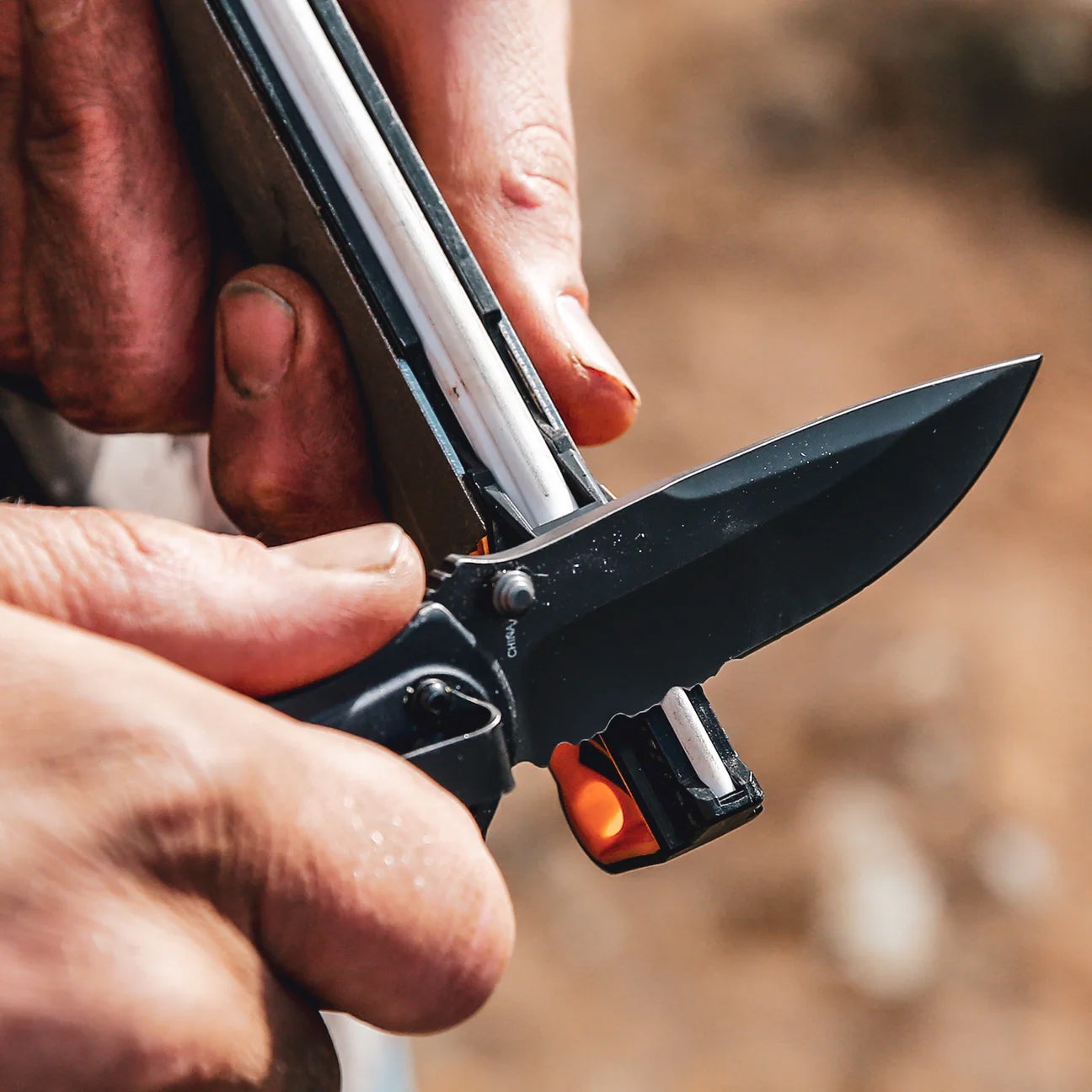A sharp knife is a safe knife. But knives also dull incrementally every time you use them. So, if you want to use a knife safely, you need know how to sharpen it. Here’s a look at all the major tools and techniques available to sharpen knives, so you can pick the one that will work best for you.
Before we dive in, let me give you the single most effective piece of knife sharpening advice out there: It is much easier to keep a knife sharp than it is to make it sharp. Maintaining a knife’s edge with frequent honing involves much less work than starting over from a dull edge. That’s why it’s so important to find a sharpening tool you like—using it every time, or every few times a knife gets used is the best way to take care of that knife.
To begin, you’ll need to learn one key piece of information about your knife: the angle of its edge. Many outdoor blades use 20 degree edges; many kitchen knives are 15 degrees. But there is no hard and fast rule here. Also of note: attempting to sharpen a knife using the wrong angle between it and an abrasive medium will dull its blade and may result in permanent damage. Look up any knife’s edge angle before attempting to sharpen it.
There are many devices and techniques out there to sharpen a knife, and each one has its pros and cons. We dove into each method to help you find the best one to suit your needs.
If you buy through our links, we may earn an affiliate commission. This supports our mission to get more people active and outside. Learn more.
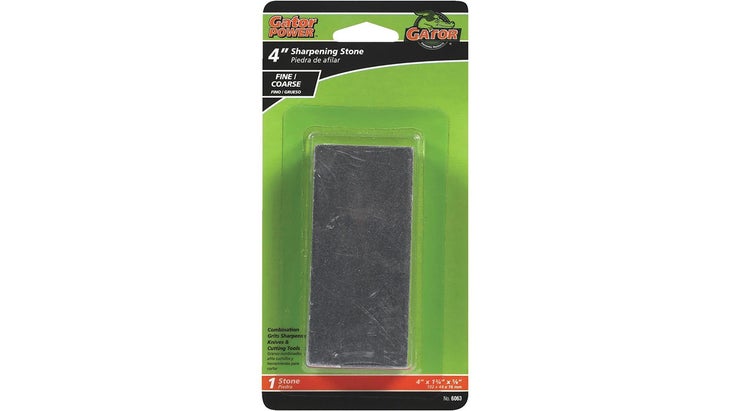
Whetstones
Affordable but They Have a Steep Learning Curve
A whetstone is just a flat, abrasive rock or synthetic stone. It’s as basic as a sharpener gets.
Pros and Cons
⊕ Cheap
⊕ Will last through generations of use
⊕ Small, robust, and easy to transport
⊗ No angle guide
⊗ Risk of cutting yourself
⊗ Not effective enough to work on very durable steel
You’ll find sharpening stones made from actual stone, ceramic, or synthetic materials. Ones that feel porous require water or oil to carry away material left behind by the action. With proper technique, a sharpening stone can be extraordinarily effective, but used incorrectly, one can also exacerbate blade wear, and alter the angle of the edge grind.
To use one, you simply push the knife along the stone, towards the edge, as if you’re trying to carve into the stone. Care must be taken to maintain a precise angle as you push the knife along the stone. And just to make things harder, most sharpening stones won’t be broad enough to span a blade’s entire length, so you must also push or pull a knife sideways as you move it forwards, again while using your hands to try and maintain that angle.
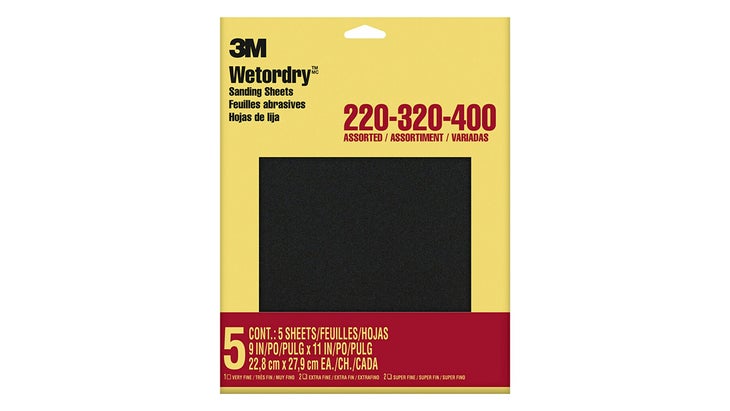
Sandpaper
Cheap but Requires Fine Motor Skills
A good substitute if you don’t have a dedicated sharpener on hand, sandpaper also allows you to choose and change the level of abrasion.
Pros and Cons
⊕ Cheap
⊕ Using different grits will deliver custom results
⊗ No angle guide
⊗ Wears out quickly
⊗ Requires precise technique
Wrap a block of some kind with sandpaper, then use it identically to that whetstone. Changing from a coarse to a fine grit as you go can help you achieve razor-like sharpness, even on very hard steels.
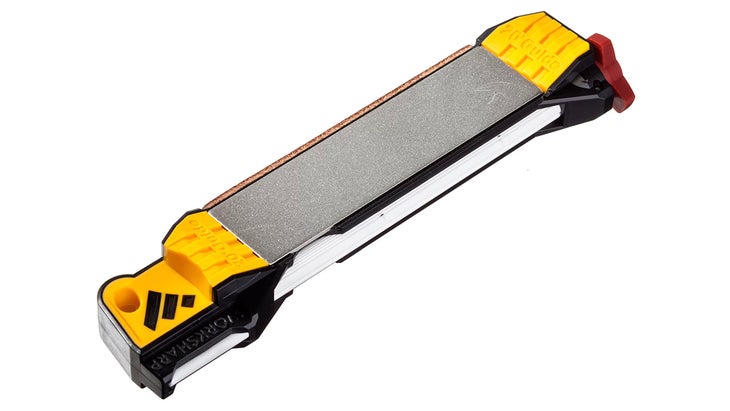
Honing Rods
Good for Everyday Touchups but Can’t Sharpen a Dull Blade
When you use or sharpen a knife, you actually roll the very thin edge to one side slightly. This is called a micro-burr, and a honing rod can get rid of the burr without removing more material.
Pros and Cons
⊕ Helps edges and blades last longer
⊕ Quick and easy to use
⊕ Little potential for error
⊗ Can’t actually remove material from edge
Softer steels sharpened at a fine angle (think: cheap kitchen knives) have a tendency to roll their edges to one side. A few swipes on a each side along a honing rod can correct this. The same thing happens to all knives when you sharpen them. This is why you try and do an equal amount of strokes along each side of the blade, but variables like pressure and duration are difficult to account for when sharpening by hand, so employing a rod at the end of any sharpening session can help ensure the edge is aligned.
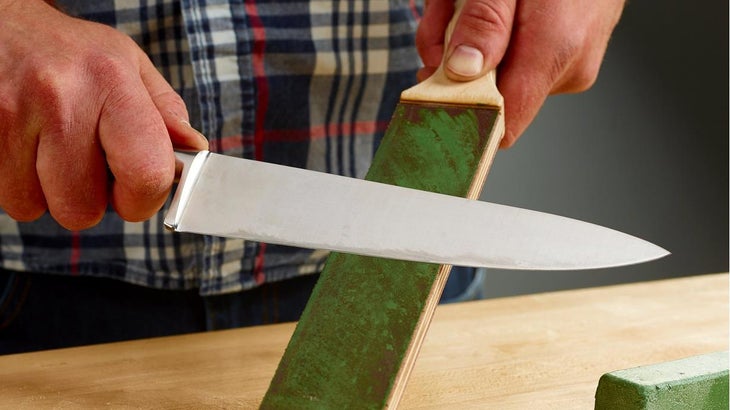
Strops
They Deliver an Ultrafine Edge—but Only After Prior Sharpening
Look at the edge of a knife under a microscope and it will appear jagged, or even serrated. Polishing that edge after sharpening can remove some of those imperfections.
Pros and Cons
⊕ Makes sharp knives sharper
⊕ Feels really satisfying
⊗ Returns diminish quickly. A quality sharpener used correctly should produce similar results.
Apply a polishing compound to a piece of leather, and run the knife along it like it’s a stone. This polishes out microscopic imperfections to create truly razor sharp edges capable of cleanly slicing without tearing.
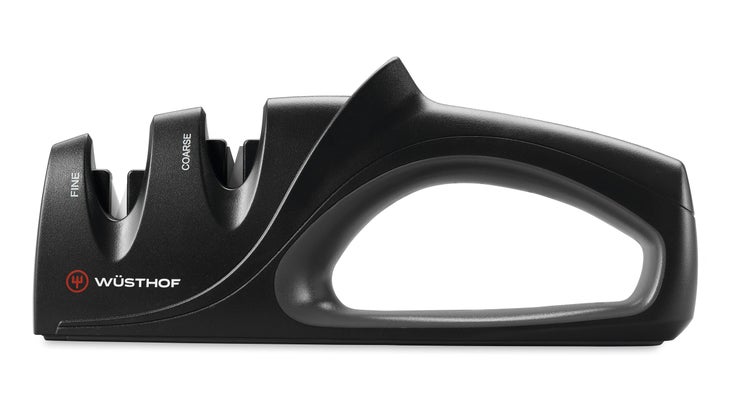
Pull-Through Sharpeners
Dead Simple but They Can Damage Your Knives
A style of sharpener commonly found in kitchens, these employ two abrasive rods set at a fixed angle inside a guide.
Pros and Cons
⊕ Cheap
⊕ Easy to use
⊗ Versions without hand guards can prove dangerous
⊗ Fixed angle isn’t compatible with many knives
⊗ Can pinch, roll, and otherwise damage edges
This is probably the kind of sharpener your grandparents kept in their kitchen. A housing holds two abrasive rods in a V shape, and can be rested on or mounted to a counter or other work surface. To use one, you just pull a knife through the V, repeating until you achieve your desired results. These things are cheap for a reason—they won’t get your knives razor sharp and could damage the blade in the process.
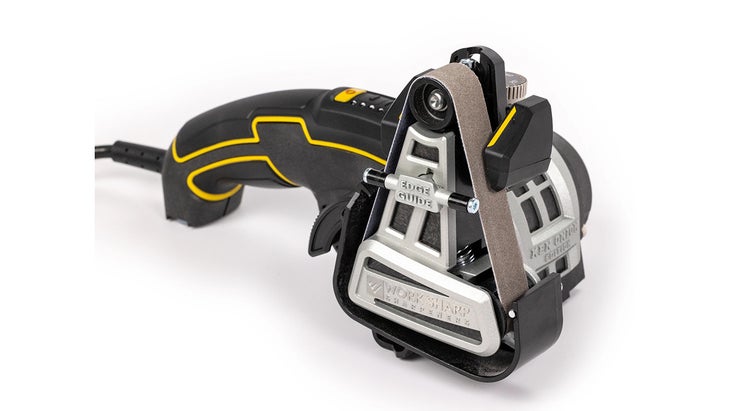
Electric Belt Sanders
They Work Quickly. Use with Great Care.
Basically just a power sander. You can actually use one of those, but dedicated sharpeners will have angle guides and other safety features.
Pros and Cons
⊕ Extremely effective
⊕ Big results in little time
⊗ Can easily damage or destroy knives if used incorrectly
⊗ Requires a power source
This is how knives are sharpened at the factory—belt sanders are the tools professional knife sharpeners employ. Some models are simple, and use belts of a single grit. Others may be more elaborate, featuring precise, alterable angle guides, hand guards, interchangeable belts, and other features.
Just be careful to read any relevant instructions, watch some video tutorials, and practice first on a knife you don’t care about. These things work well enough that you can quickly round a blade’s tip, destroy a steel’s heat treatment, or cause undue wear—even in just a few seconds of carelessness.
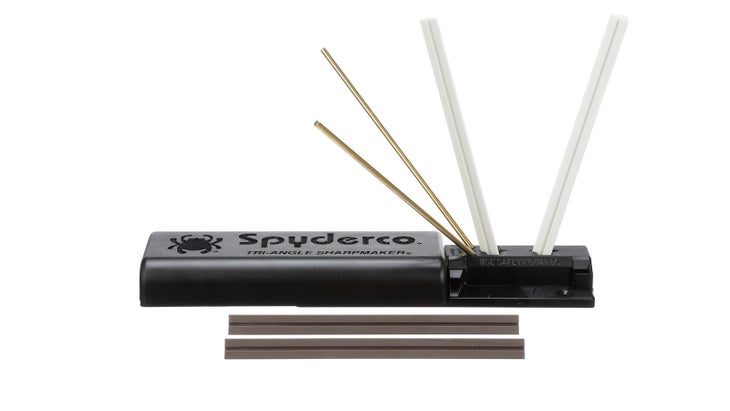
Ceramic Rods
Safe and Easy to Use but They Require Patience
Set into holes in a stable base, ceramic rod sharpeners help maintain a consistent angle while protecting your hands.
Pros and Cons
⊕ Consistent results
⊕ Easy to use
⊕ Safe
⊗ Results can be limited on harder steels
⊗ Ceramic rods break when dropped
Addressing the major issues inherent in whetstones, ceramic rod sharpeners work on similar principles, but are far easier to use. Simply pull a knife down the guided rods, and repeat until the edge is sharp.
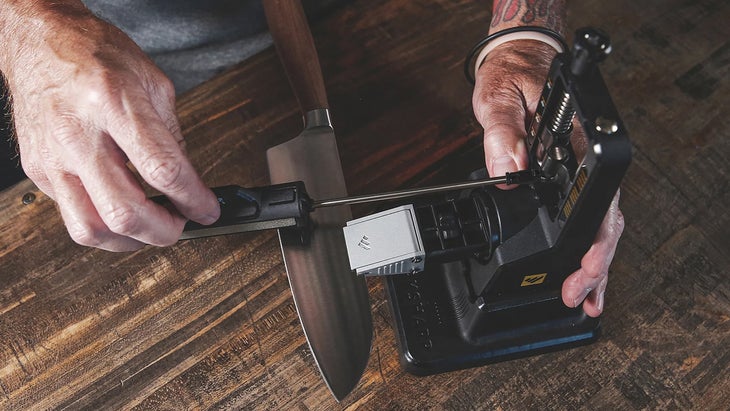
Guided Angles
Expensive and Time-Consuming, but You Can’t Argue with the Results
These things combine precise angle control while the gentle nature of manual sharpening.
Pros and Cons
⊕ Easy on your blade
⊕ Extremely effective
⊗ Can be expensive
⊗ Time consuming to set up
⊗ Results require patience
To use a guided angle sharpener, just clamp it to the edge of a counter or workbench, install the correct angle guide, clamp in your knife, then manually sweep ceramic abrasives in swappable grits across your edge. These are a great option for expensive knives because the angle between blade and abrasive is precisely controlled, and you can be as gentle as you need, or really bear down on the handle to bring a dull knife back from the dead. I struggle to find the patience to set mine up and take it down, so even while this is likely the most effective option, it’s also one it takes commitment to employ regularly.
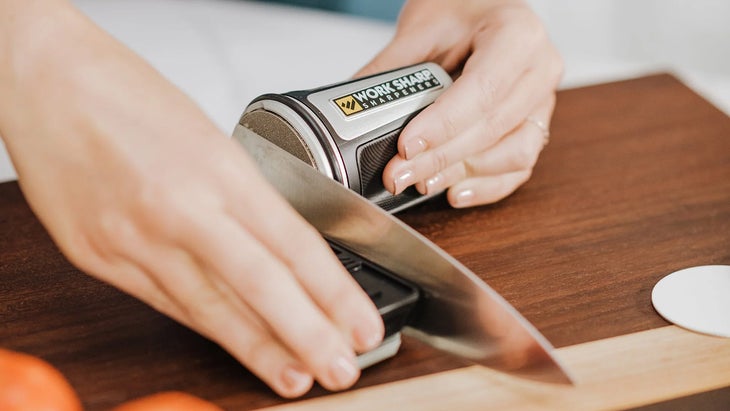
Rolling Stones
Foolproof, but Can Only Get Your Knives So Sharp
Also combining precise angle control with manual operation (and few or no moving parts), these promise to work as well as a Guided Angle sharpener, with no setup or takedown.
Pros and Cons
⊕ Dead simple
⊕ Gentle on your blades
⊕ Precise angle control
⊗ Limited effectiveness
⊗ Incompatible with some blade designs
These burst into social media prominence out of nowhere in the last couple of years. I bought one on the promise that it’d be as foolproof as a guided angle sharpener without all the hassle, but was immediately disappointed when the angle guide (a magnetic block you place on your counter, then push the blade against) refused to hold a saber-ground knife securely at the 20 degrees I needed.
To use one, you just use that guide to hold your knife inverted, then roll the sharpener back and forth while pushing your hands together to create pressure. Swapping wheels to different grits can achieve progressively finer results.


